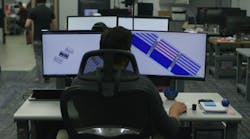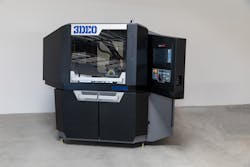Q&A: How Design for Additive Manufacturing Can Benefit the Development Process
3DEO, a Los Angeles-based metal 3D printing company, has added design for additive manufacturing (DfAM) to its service offering. Providing this early-stage component to its services enables the company to aid customers throughout the entire product lifecycle while also helping to ensure components are optimized for 3D printing.
Having the right design from the start of the 3D printing process ensures the final product will perform as desired. Using DfAM can save design teams a lot of headaches by enabling them to determine early on if their component can even be 3D printed as not everything is suited to this production method.
In addition, 3D printing offers the opportunity in some instances to rethink traditional component designs. Employing DfAM at the beginning of the development process allows any possible modifications to be determined.
READ MORE: Additive Manufacturing Brings Opportunities to Improve Component Design and Production
In this Q&A with Power & Motion, Matt Sand, President and co-founder of 3DEO, explains how the company’s DfAM service came to be part of its offering, the benefits it provides and where he sees 3D printing headed in the future.
Power & Motion (P&M): Why did 3DEO decide to add design for additive manufacturing (DfAM) to its offering?
Matt Sand (MS): Up to this point, we have been working with end-use production customers for many years, competing directly with CNC machining and metal injection molding (MIM). Over the years, it has become obvious that the only way to unlock the full potential of additive manufacturing, and realize the next generation of products, is to design specifically for additive manufacturing. It is one thing to print a part that has been designed for MIM. It is different and game-changing to approach applications from the beginning with the mindset that we are going to fundamentally rethink how we solve this problem with the full power of 3D printing. Our customers have been asking for us to help for years, and we are finally at the stage of our company that we have the design and applications engineering resources and expertise to be able to dive in headfirst with our customers. We can design for them or train them how to think about design to enable their own team.
P&M: What is the benefit of a manufacturer utilizing DfAM?
MS: Using DfAM in product development allows engineers and designers to approach problems fundamentally differently. No longer bound by complexity and manufacturability limitations of conventional manufacturing, customers are able to reimagine solutions. More than that, with 3D printing, they can iterate quickly on ideas to see if it will work. If not, no big deal, we can update the design and try again. If it does work, we now have a scalable solution in which the same printers used to qualify the design and product are used to make production parts. This means there is that much less risk in the full cycle of product development.
P&M: Could you provide an overview of how the company provides this service? Is there special technology utilized? What makes it different or unique compared to that possibly offered by other companies?
MS: We have a really smart applications engineering team that is well-versed in conventional manufacturing and cutting edge 3D printing. Because of this, if there’s a better way to design or make something conventionally, we will recommend that. If it’s possible to leverage 3D printing to redesign a product in a way that improves performance or significantly reduces total cost of production, then we can also recommend that. In designing for 3D printing, 3DEO has developed a proprietary suite of software tools for design and production to approach these problems. But really, our big differentiator is our team.
P&M: Are there specific applications or 3D printing jobs for which this type of service would be most beneficial?
MS: 3D printing is a great tool for a wide variety of end-use applications and markets. We focus primarily on medical, industrial, consumer products, and aerospace and defense applications. This service is broadly applicable to any type of product development.
P&M: How is your company seeing the role of 3D printing evolving?
MS: 3D printing is emerging from a strictly prototyping technology to a mainstay in the toolkit of innovation and production. That is the really big news that people need to pay attention to, because if you miss it you might lose out on a significant competitive advantage to others who do take advantage of it. The ecosystem of additive manufacturing for production is emerging in a big way, and it will stand on its own alongside machining, casting, and injection molding.




